Figures & data
Table 1. Statistical parameters and normalized correlations chosen to characterize two important classes of fractal (-like) aggregates (FAs).
Figure 1. Predicted behavior of aggregate “momentum shielding function”: Smom(Kn1; N); dependence on Knudsen number (based on spherule radius) and total spherule number n (>>1); unless otherwise specified results are for diffusion-limited cluster aggregates with Df = 1.8. (See Section 2.3 for test of ASM; see the Appendix for a special case: Df = 3 with uniform [low] solid fraction [dashed contours].)
![Figure 1. Predicted behavior of aggregate “momentum shielding function”: Smom(Kn1; N); dependence on Knudsen number (based on spherule radius) and total spherule number n (>>1); unless otherwise specified results are for diffusion-limited cluster aggregates with Df = 1.8. (See Section 2.3 for test of ASM; see the Appendix for a special case: Df = 3 with uniform [low] solid fraction [dashed contours].)](/cms/asset/6f5ddf8e-254c-4c1b-ab1b-dde382eb782f/uast_a_1410095_f0001_b.gif)
Figure 2. Predicted behavior of aggregate “momentum shielding function”: Smom(Kn1; N); dependence on Knudsen number (based on spherule radius) and total spherule number N (>>1) for reaction-limited cluster aggregates with Df = 2.1; comparison between results of permeable sphere model (Section 2.1 and the Appendix) and correlation ( and Sorensen Citation2011).
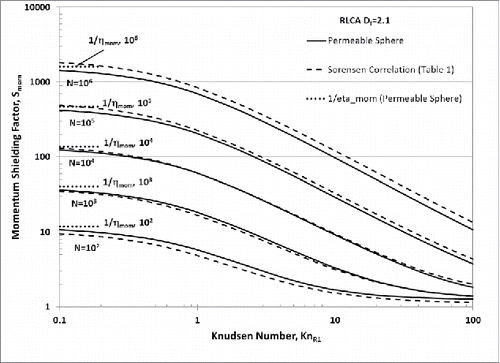
Figure 3. Predicted deposition rate ratios resulting from mainstream aggregation (at const total spherule volume fraction). Sensitivity to particle deposition mechanism and Knudsen number, (mfp)/R1, for monodisperse mainstream aggregate population (all particle with N = 1000 and σg = 1) and coagulation-aged, “self-preserving” populations of DLCAs, = O(103) with Df = 1.8.
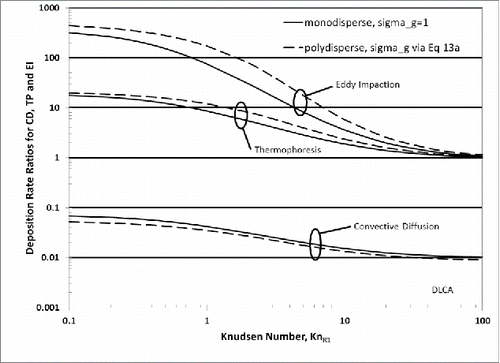
Figure 4. Predicted deposition rate ratios resulting from mainstream aggregation (at const total spherule volume fraction). Sensitivity to particle deposition mechanism and Knudsen number, (mfp)/R1, for monodisperse mainstream aggregate population (all particle with N = 1000 and σg = 1) and coagulation-aged, “self-preserving” populations of RLCAs, = O(103) with Df = 2.1.
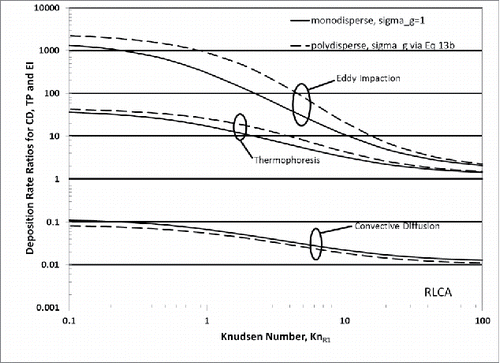
Figure 5. Predicted mainstream and wall fractal-like aggregate distributions due to expected N-dependent convective diffusion, thermophoretic diffusivities and eddy impaction deposition rates. Comparison between mainstream- and predicted wall-log-normal distributions mainstream aggregate population characterized by Ng,∞ = 1000, Df = 1.8 and KnR1 = 1.32.
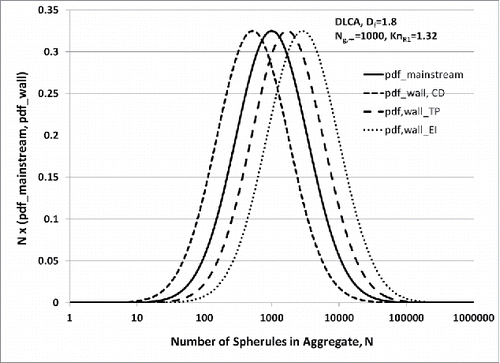
Figure 6. Predicted mainstream and wall fractal-like aggregate distributions due to expected N-dependent convective diffusion, thermophoretic diffusivities, and eddy impaction deposition rates. Comparison between mainstream- and predicted wall-log-normal distributions mainstream aggregate population characterized by Ng,∞ = 1000, Df = 2.1, and KnR1 = 1.32.
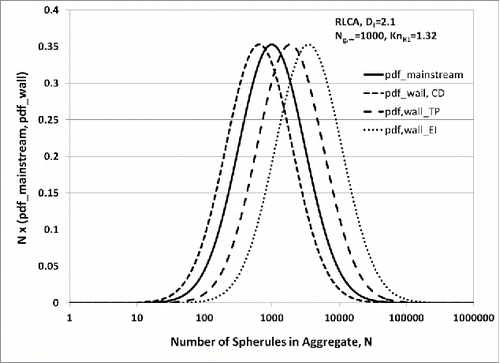
Figure A1. Behavior of the Brinkman function, fB(κ), describing the drag on a sphere of uniform permeability in Re << 1 Flow when KnN << 1; log-log representation of Equation (EquationA1[A1] ) showing asymptotic behavior at small and large dimensionless radius, ≡ Rmax/χ1/2.
![Figure A1. Behavior of the Brinkman function, fB(κ), describing the drag on a sphere of uniform permeability in Re << 1 Flow when KnN << 1; log-log representation of Equation (EquationA1[A1] ) showing asymptotic behavior at small and large dimensionless radius, ≡ Rmax/χ1/2.](/cms/asset/b561aafb-f320-47e3-812a-0c682743965f/uast_a_1410095_uf0001_b.gif)
